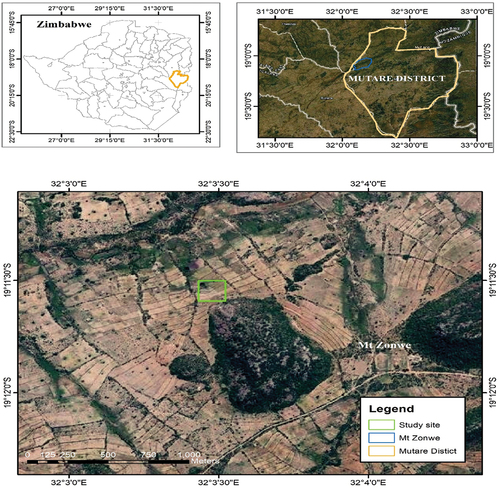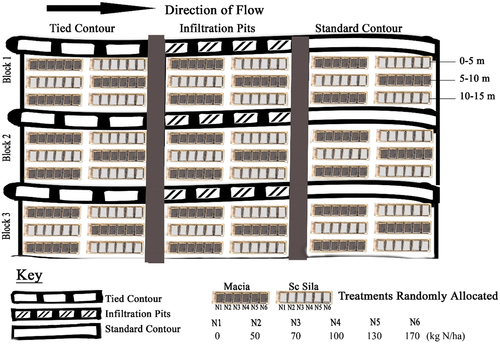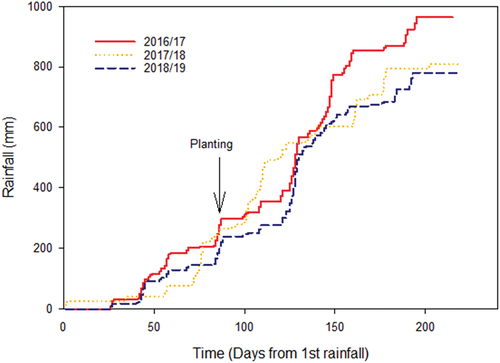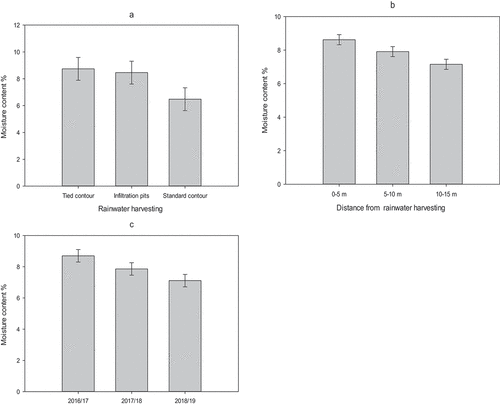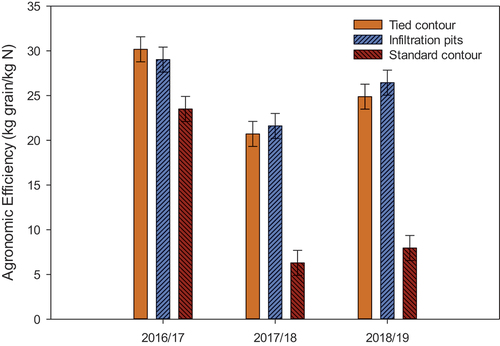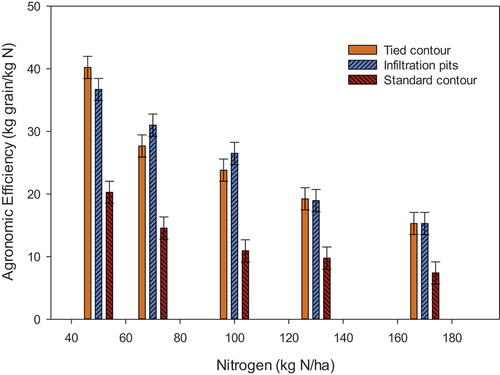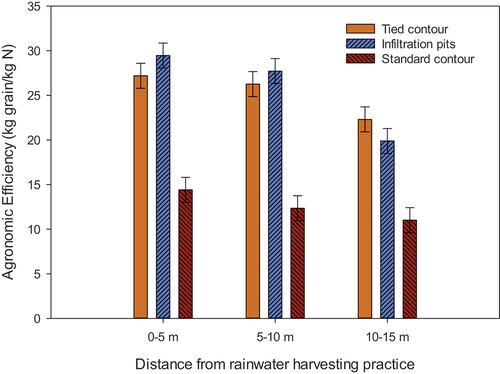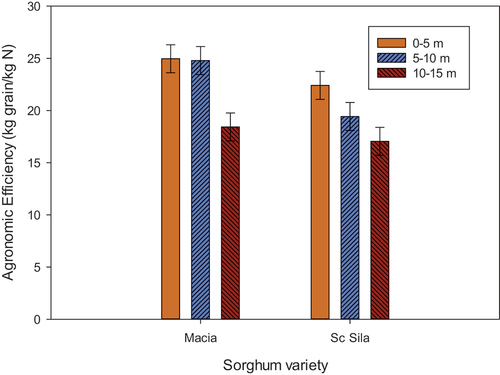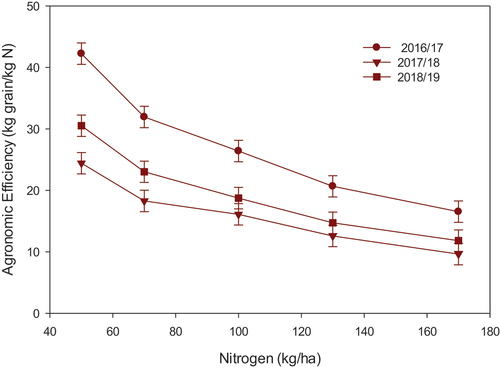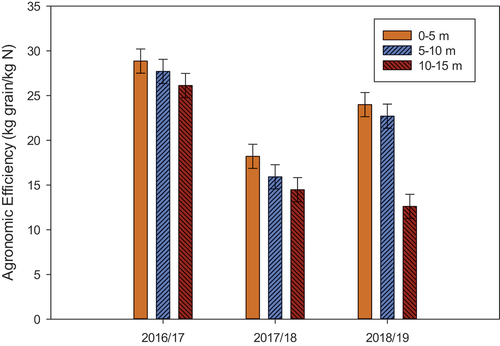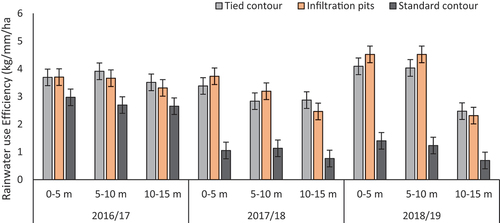Abstract
Nitrogen and rainwater use efficiency in semi-arid smallholder farming systems is low due to low soil fertility and unreliable rainfall. The objective of this study was to evaluate the effect of rainwater harvesting and mineral nitrogen fertilizer on nitrogen and rainwater use efficiency under two sorghum (Sorghum bicolor) varieties. A split-split plot experiment, replicated three times, was conducted in Mt Zonwe smallholder farming area from 2016/17 to 2018/19. The results showed that water content under tied contour (TC) and infiltration pits (IP) had significantly higher water content compared to standard contour (SC) and moisture content significantly decreased with an increase in distance from RWH practices. TC and IP had higher agronomic efficiency than SC across all nitrogen applications, distance from RWH practice, and seasons. Sorghum variety Macia had higher nitrogen use efficiency indices than Sc Sila at nitrogen application of 50 and 70 kg N/ha while nitrogen application >100 kg N/ha had no difference in nitrogen use in both varieties. A decreasing trend in nitrogen productivity with an increase in nitrogen application was shown in both varieties. Mineral nitrogen fertilizer application increased rainwater productivity up to 100 kg N/ha beyond which there was no significant difference. Regardless of sorghum variety and season, TC and IP had higher rainwater use efficiency than SC at each distance from RWH practice. This study recommends the integrated use of TC and IP rainwater harvesting practices and mineral nitrogen fertilizer sustainably to improve N and rainwater productivity in semi-arid smallholder sorghum farming systems.
1. Introduction
The global crop demand is estimated to increase by 100% to 110% from 2005 to 2050 to meet global food demand (Hunter et al., Citation2017; Serraj et al., Citation2019). Sustainably meeting such demand may be an immense challenge, particularly in the face of declining soil fertility and frequent droughts due to climate change. Sorghum has the potential to meet the food demand but is mainly grown in areas with low and erratic rainfall and poor soil fertility, resulting in very low yields (Hadebe et al., Citation2021). Yields will not improve until smallholder farmers apply adequate mineral fertilizer and employ water management practices that conserve soil moisture and increase the water availability to the plant. Sustainable water and nutrient management must be adopted to achieve the required yield benefits. Economical use of nutrients improves food security and minimizes environmental pollution through nutrient loss (Clark & Tilman, Citation2017; Kopittke et al., Citation2019). Improving rainwater and nutrient use is among the imported research issues in sub-Sahara Africa (Hatfield & Dold, Citation2019), the objective being to increase the productivity of rainwater and nutrients while minimizing water and nutrient losses from the field (Vidican et al., Citation2020).
Increasing rainwater and nutrient use efficiency in smallholder farming systems can reduce production costs while productivity increases to meet projected food demand. Therefore, higher profitability can be achieved by placing more emphasis on the high efficiency of nutrient and rainwater use. The development of better rainwater harvesting management practices and the use of adapted high-yielding sorghum cultivars is important to realize increased nutrient and water productivity. Nutrient management practices such as 4 R Nutrient Stewardship, aim at the application of the adequate nutrient source, at the right application rate, at the right place, and at the right time (Bruulsema et al., Citation2019; Fixen et al., Citation2015) need to be adopted. It is critical to understand nutrient and rainwater use to improve sorghum (Sorghum bicolor) yield in arid and farming environments. Rainwater and nutrient use are crucial principles for assessing crop production systems in rainfed agriculture and can be greatly improved by fertilizer management as well as soil-plant-water relationships.
Nutrient use efficiency (NUE) has been defined as the ratio of nitrogen removed from harvested products to the amount of nitrogen applied (Bijay-Singh & Citation2017). Partial factor productivity and agronomic efficiency are the most commonly used indices of nitrogen use efficiency. They determine a cropping system’s efficiency concerning its nutrient supply (Norton, Citation2017). Lower levels indicate less sensitive soils or excessive nutrient application, while higher levels indicate that nutrient supply is restricting productivity. Agronomic efficiency is a useful performance indicator, especially when selecting more efficient genotypes for nutrient uptake or evaluating nutrient transfers between soil pools (Norton, Citation2017). In nutrient use efficiency indices, as nutrient application rates approach their optimum, productivity rises, but at a slower pace, and NUE falls (Singh et al., Citation2018). Source, time, and place factors, as well as other cultural practices, soil, and climatic conditions determine the degree of the decline (Fixen et al., Citation2015). Nutrient use efficiency can be doubled when nitrogen application methods underpinned by the 4 R nutrient stewardship principles and water management practices such as rainwater harvesting are adopted (Ahmad et al., Citation2018).
Masso et al. (Citation2017) reported low agronomic efficiency and partial factor productivity in smallholder farming systems due to inappropriate agronomic practices such as blanket fertilizer guidelines, and too low fertilizer application rates coupled with unbalanced fertilization. Fertilizer recommendations such as 200 kg/ha basal fertilizer and 150 kg/ha top dress in sorghum production are focused on achieving optimum output on resource-rich farms (Ganyo et al., Citation2019). This is because mineral fertilizer accounts for a significant portion of production costs, and low profitability appears to influence a farmer’s decision to use it or not (Mtangadura et al., Citation2017; Wortmann et al., Citation2019). General fertilizer guidelines, even though they are appropriate for a small number of situations (biophysical and socioeconomic), would invariably be ineffective for others (Cedrez et al., Citation2020). Furthermore, the application rates are undifferentiated by region, soil conditions, or classification. As a consequence, many farmers disregard them; if they use them, it will result in wasteful or unprofitable mineral fertilizer usage. Therefore, there is a need to constantly carry out research to determine the site and crop-specific optimum fertilizer application rates for better nutrient use efficiency to reduce costs and environmental pollution due to excess application (Ichami et al., Citation2019; Rurinda et al., Citation2020). Nitrogen flows through the system have negative consequences when applied at an inappropriate time, rate, form, and place reducing nutrient use efficiency (Ahmad et al., Citation2018; Bruulsema et al., Citation2019; Fixen et al., Citation2015).
Rainwater use efficiency is another important primary factor in improving sorghum yield under water scarcity in rainfed agriculture (Hadebe et al., Citation2020). Water use efficiency is the yield output per unit of evapotranspiration (Mabhaudhi et al., Citation2016) influenced by crop morphological and physiological traits, genotype, plant population, and soil conditions such as soil water-holding capacity, metrological conditions, and agronomic practices (Hadebe et al., Citation2017). An appropriate sorghum variety should maintain high rainwater use efficiency to improve yield under water-limiting conditions (Hadebe et al., Citation2020). Therefore, crop selection and rainwater harvesting are among agronomic activities for increasing rainwater use efficiency. In this view, the inclusion of suitable drought-tolerant sorghum and rainwater harvesting practices can improve rainwater use efficiency in rainfed and semi-arid environments.
In Zimbabwe, smallholder sorghum production takes place in semi-arid rain-fed farming systems where soils are inherently infertile and subject to unreliable rainfall resulting in variable nutrient and rainwater productivity (Tonitto & Ricker-Gilbert, Citation2016). Since soils are susceptible to various types of erosion hazards (physical, chemical, and biological), effective management strategies are needed to increase or maintain soil nutrient and rainwater productivity (Masso et al., Citation2017). The soils in smallholder farmer fields are mostly sandy, ranging from sandy loamy to loamy sands, and are deficient in a variety of nutrients, especially nitrogen (Nezomba, Citation2016). The soils have also been depleted of meagre nutrients by continuous cereal mono-cropping at sub-optimal fertilization rates, resulting in low productivity. There is little likelihood of increasing nutrient and rainwater productivity unless nutrient levels and rainwater management improve (Tamagnone et al., Citation2020). Fertilizer application and rainwater harvesting (RWH) can have a major impact on increasing smallholder nutrient and rainwater use efficiency (Ngosong et al., Citation2019).
However, the use of mineral fertilizer is sub-optimal because of high costs, unavailability, high risk due to uncertain rainfall, and incorrect fertilizer recommendations. Abunyewa et al. (Citation2017) noted that very limited research has been conducted in semiarid rain-fed farming systems to exploit the possible synergistic effects of rainwater harvesting and nutrient application on crop production. Rainwater and nutrient use efficiency have not received much attention under contour-based rainwater harvesting practices in rain-fed agriculture. Nitrogen use efficiency of crops under dry-land conditions depends largely on available water to the plant that depends on rainfall. The objective of this study was to evaluate the effect of tied contour and in-contour infiltration pits rainwater harvesting and mineral nitrogen fertilizer use on nutrient and rainwater use efficiency under two sorghum varieties in a rainfed smallholder semi-arid farming system.
2. Materials and methods
2.1. Study site
The study was carried out in 2016/17–2018/19 cropping season at the Zonwe smallholder farming area in the Mutare district of Zimbabwe (19° 11’30“S; 32° 03’28” E, 835 m above sea level) (Figure ). The region is a part of agricultural region IV, which is known for its low, unpredictable, and uneven rainfall. The yearly total rainfall during the unimodal rain season of October to March is approximately 650 mm, with a mean annual temperature of 27°C. The soils, which are primarily made of sand, are produced from granitic parent material and are typically poor in nitrogen and phosphate. The three main crops that farmers grow are sorghum bicolor, millets (Pennisetum glaucum and Eleusine coracana), and cotton (Gossypium hirsutum). Data for the soil physicochemical properties of the study sites and nutrient content are presented in Table .
Table 1. Soil Physico-chemical characteristics of the experimental site
2.2. Soil sampling and analysis
A total of 15 soil samples were collected before planting in the experimental field measuring 90 × 45 m from a depth of 0–30 cm in a zig-zig manner using a soil auger. To evaluate the soil Physico-chemical properties of the study site, a composite sample was prepared for analysis. Air-dried composited soil sample was ground and sieved through a 2 mm sieve. The Kjeldahl method (Cottenie, Citation1980) was used to determine total nitrogen and organic carbon was determined using the wet digestion method (Walkley & Black, Citation1934). Available phosphorous was determined using the Olsen method (Olsen, Citation1954), and soil texture by the Bouyoucos Hydrometer method (Bouyoucos, Citation1962). Soil pH was determined using the CaCl2 method (Henderson & Bui, Citation2002). Summary data for soil Physico-chemical characteristics of the study site are presented in Table .
2.3. Experimental design
Three replications of a split-split plot experimental design were used. The experimental units were made up of three contour lines that follow one another and are separated by 15 m, with each line being 90 m long. The lengths were modified into tied contour, infiltration pits, and standard contour which served as the control. The modification was based on F. Kubiku et al. (Citation2022). A space 2 m wide was left between the rainwater harvesting practices along each contour. The rainwater harvesting methods were the main plot factor. Tied contours were made up of cross ties forming micro ponds measuring 5 m long by 0.5 m broad by 0.5 m deep, while, infiltration pits were dug at intervals of 0.5 m, each measuring 2 m long by 0.5 m broad by 0.5 m deep. The tied contour, infiltration pits, and standard contour were 30 m along the contour channel (Figure ). Subplot factor consists of two sorghum varieties Sc Sila and Macia grown under each rainwater harvesting practice. The dimensions of each sub-plot factor were 15 m in length and 4.5 m wide. Within each rainwater harvesting technique, sub-sub plot factors of nitrogen application rates measured 2 m x 4.5 m and were repeated three times. Replicates were categorized into three distances from each rainwater harvesting practice namely 0–5 m, 5–10 m, and 10–15 m (Figure ).
2.4. Experimental procedure
The land was prepared using conventional tillage methods by ploughing using an ox-drawn plough at a depth of 20 cm. The experimental field was planted in December after receiving the first effective rainfall of the season. Furrows were opened by an ox-drawn plough spaced at 0.75 m in each treatment. Sorghum varieties Sc Sila and Macia were grown under the three rainwater harvesting practices—tied contour, infiltration pits, and standard contour. Sorghum varieties were randomly drilled at 12 kg/ha into the furrows in each plot. A basal NPK (7:6:6) fertilizer was applied along the furrows at a rate of 200 kg/ha in all the treatments. Two weeks after crop emergence thinning was done leaving individual sorghum plants spaced at 10 cm along the furrow to give a target plant population of 133 333 plants/ha in all the treatments. Nitrogen levels of 0; 50; 70; 100; 130 and 170 kg N/ha were used for top dressing using ammonium nitrate (34.5%) top dressing fertilizer after 5 weeks of crop emergence. A 0 kg N/ha treatment was left as a control in each subplot factor. Weed control was done using hand hoes in all the plots as weeds emerge. Incidence of Fall armyworm (Spodoptera frugiperda) was recorded and controlled using Ecoterex (Deltamethrin and Pirimiphos methyl) pesticide and bird scaring was done at the heading stage to harvest maturity. Rainfall was recorded by the farmer with a rain gauge placed at the experimental site.
2.5. Data collection
2.5.1. Water content
The gravimetric method was used to determine the soil water content in each rainwater harvesting practice at a depth of 30 cm at varying distances of 0–5 m, 5–10 m, and 10–15 m from the rainwater harvesting practices. Moisture content was measured every month in all the seasons from the time of planting until physiological maturity.
2.5.2. Nitrogen use efficiency
The nitrogen contained in basal fertilizer and top-dressing fertilizer was used to compute the agronomic efficiency.
Nitrogen efficiency (NUE) (kg grain/kg N) was computed using the following formula:
Agronomic efficiency (AEN)= [Grain yield of mineral nitrogen fertilizer applied plot (kg/ha)—Grain yield of mineral nitrogen unfertilized plot (kg/ha)]/[N fertilizer applied (kg/ha)]
Where N is the total mineral fertilizer N applied + N supplied by the soil,
2.5.3. Rainwater use efficiency
Rainfall was recorded by the farmer using a rain gauge installed at the experimental site. Rainwater use efficiency (RUE) was computed using the following formulae:
RUE = GY/(R+M)
Where RUE is the rainwater use efficiency (kg/mm/ha), GY is sorghum grain yield (kg/ha), R is the residual moisture at the time of planting and M is cumulative rainfall from time of planting to physiological maturity.
2.6. Data analysis
Gravimetric water content, agronomic efficiency, and rainwater use efficiency data were tested for normality and homoscedasticity using the Kolmogorov–Smirnov test and Bartlett test, respectively. The error of the variances for the three seasons was homogenous, the data for each season was not examined separately. Data were subjected to statistical analysis of variance for a split-split plot using Genstat statistical software and the least significant difference test at 0.05 was performed to separate significant treatment means.
3. Results
3.1. Rainfall
The growing seasons received more rainfall than the long-term average (650 mm) of the farming region. The wettest season was experienced in 2016/17 with 48% more rainfall being received than the long-term average of 650 mm for the region (Figure ). Mid-season dry spells were experienced in all years despite high rainfall totals being experienced and coinciding with the booting stage of the crop. Cumulative rainfall was the least in the 2018/19 season with a severe mid-season dry spell. Seasons characterized by high rainfall intensities generate more runoff from the catchment area for collection by rainwater harvesting structures.
3.2. Water content
The rainwater harvesting practices tied contour and infiltration pits showed significantly higher soil moisture content compared with the standard contour (p < 0.05) (Figure ), and soil moisture considerably decreased as the distance from rainwater harvesting increased Figure ). There was significant variation in soil moisture across seasons with the 2016/17 season showing the highest soil moisture while the 2018/19 season recorded the lowest soil moisture (Figure ).
3.3. Agronomic efficiency
3.3.1. Effect of RWH practice × season on AEN
The results showed that AEN was influenced by the interaction effect of RWH practice and season. The RWH practices, TC and SC showed no significant difference in AEN in all the seasons while the SC had significantly low (p < 0.05) AEN across all seasons (Figure ). The mean AEN of TC and IP were 25.25 and 25.69 kg grain/kg N respectively while the SC had 12.59 kg grain/kg N.
3.3.2. Effect of RWH practice × nitrogen application on AEN
The analysis of variance showed significant interaction (p < 0.05) effect of RWH and nitrogen application on AEN. Tied contours and IP had higher AEN than SC at all nitrogen application rates (Figure ). There was no significant difference in AEN between TC and IP. A gradual decrease in AEN was shown in each RWH practice with nitrogen application of 50 kg N/ha showing the highest AEN while nitrogen application rate of 170 kg N/ha had the lowest AEN.
3.3.3. Effect of RWH × distance from RWH practice on AEN
Significant interaction effect (p < 0.05) of RWH and distance from RWH practice influenced AEN. At each distance from RWH practice, TC and IP showed comparable AEN, but significantly higher than the SC (Figure ). The AEN was in the range of 22.3–27.2 kg grain/kg N under TC, 19.9–29.5 kg grain/kg N under IP, and (11–27.2 kg grain kg/N) under SC across the distances from RWH practice.
3.3.4. Effect of sorghum variety × nitrogen application on AEN
The interaction effect of sorghum and nitrogen significantly (p < 0.05) influenced AEN with sorghum variety Macia showing higher AEN than Sc Sila at nitrogen application of 50 and 70 kg N/ha while there was no significant difference in AEN at nitrogen application rates >100 kg N/ha in both sorghum varieties (Figure ). A decreasing trend in AEN with an increase in nitrogen application was shown in both varieties with the highest and least AEN at 50 kg N/ha and 170 kg N/ha, respectively.
3.3.5. Effect of sorghum variety × distance from RWH practice on AEN
Sorghum variety and the distance from RWH practice had a significant interaction effect (p < 0.05) on AEN. The sorghum varieties showed variations in AEN at each distance from RWH practice. In the sorghum variety Macia, the distance between 0–5 m and 5–10 m showed no significant difference in AEN, but a significantly higher AEN at a 10–15 m distance from the RWH practice (Figure ). The sorghum variety Sc Sila had greater AEN at 0–5 m than distances >5 m from RWH practice. The AEN was in the range of 18.43–2496 and 17.05–241 kg grain/kg N under the sorghum varieties Macia and Sc Sila, respectively.
3.3.6. Effect of nitrogen application × season on AEN
The interaction effect of sorghum variety and season had a significant effect (p < 0.05) on AEN. The season 2017/16 had significantly higher AEN at each nitrogen application rate compared to the 2017/18 and 2018/19 seasons (Figure ). Nitrogen application of 50 kg N/ha had the highest AEN in each season while the lowest AEN was lowest at a nitrogen application rate of 170 kg N/ha in each season. A significant decreasing trend in AEN was shown with an increase in nitrogen application across seasons (Figure ). The AEN was in the range of 16.54–42.25 kg grain/kg N (2016/17), 9.64–24.42 kg grain/kg N (2017/18) and 11.82–30.53 kg grain/kg N (2018/19).
3.3.7. Effect of distance from RWH × season on AEN
The AEN significantly varied with distance from RWH practice in each season. The 2016/17 season had no significant difference in AEN at each distance from RHW practice. In the 2017/18 season, the distance of 0–5 m had significantly higher AEN than the 10–15 m distance while the 5–10 m and 10–15 m distance from RWH showed comparable AEN (Figure ). Significant differences in AEN were more apparent 2018/19 season where 0–5 m and 5–10 m distances showed higher AEN than the 10–15 m distance from the RWH practice. The AEN was in the range of 26.13–28.86 kg grain/kg N (2016/17), 14.48–18.21 kg grain/kg N (2017/18), and 12.61–23.99 kg grain/kg N (2018/19). However, a general decrease in AEN was also observed with an increase in distance from the RWH practice in all seasons (Figure ).
3.4. Rainwater use efficiency (RUE)
The effect of RWH practice, sorghum variety, and distance from RWH practice are presented in Table . Significant interaction effects among the treatments except for nitrogen largely explain for variation in rainwater use efficiencies observed.
Table 2. Effect of RWH practices, sorghum variety, nitrogen application, and distance from RWH practice on rainwater use efficiency
Nitrogen application had a significant effect (p < 0.05) on rainwater use efficiency. Nitrogen application of 50 and 70 kg N/ha had no significant difference in rainwater use efficiency (2.66; 2.63 kg grain/mm/ha) but was lower than nitrogen application >100 kg N/ha (Table ). Nitrogen application rates >100 kg N ha had no significant difference with rainwater use efficiencies of 2.97; 2.95; 3.00 kg grain/mm/ha at 100; 130 and 170 kg N/ha, respectively.
3.4.1. Effect of RWH practice × sorghum variety × distance from RWH practice on RUE
The significant interaction effect (p < 0.05) of RWH practice × sorghum variety × distance from RWH practice influenced rainwater use efficiency. In sorghum variety, Macia, TC, and IP had comparable rainwater use efficiency, but significantly higher than standard contour at each distance from RWH practice. A similar trend was observed in sorghum variety Sc Sila except for 5–10 m distance which showed significant differences between TC and IP (Figure ).
3.4.2. Effect of RWH practice × distance from RWH practice × season on RUE
A significant interaction (p < 0.05) effect of RWH × distance from RWH practice × season was shown on rainwater use efficiency. In all three cropping seasons, TC and IP had significantly higher rainwater use efficiencies than SC at each distance from RWH practice (Figure ). There was no substantial difference in rainwater use efficiency between TC and IP across all distances from RWH practice in each season.
4. Discussion
4.1. Water content
The higher water content shown by tied contour and contour infiltration pits was attributed to their ability to collect runoff water creating a moisture reservoir for later use by crops. Similar observations were made by (F. Kubiku et al., Citation2022; F. N. Kubiku et al., Citation2022) in studies carried out in the semi-arid region of Zimbabwe. The gradual decrease in soil moisture with an increase in distance from rainwater harvesting practice explained the laws of diffusion which governs water flow in the soil. Water movement in the soil is affected by distance from the source point. The seasonal variation in soil moisture observed across seasons was attributed to the amount of rainfall received during the growing season. The 2016/17 season had received more rainfall total which corresponded to more soil moisture while the 2018/19 season received low rainfall which also corresponded to lower soil moisture.
4.2. Agronomic efficiency
The higher AEN observed under TC and IP rainwater harvesting practices than the SC in all the seasons was attributed to their capacity for rainwater capture and subsequently releasing it through lateral flow resulting in higher water content (gwc). Moisture influences nitrogen uptake and use (Abunyewa et al., Citation2017). The low AEN shown under the SC was attributed to low poor water retention due to greater runoff rainwater resulting in low water content. Low soil moisture reduced nutrient uptake and nutrient utilization resulting in low yield and hence low agronomic efficiency.
The interactive effects of RWH and nitrogen application on AEN were also evident with TC and IP showing comparatively higher AEN at each level of nitrogen application than the SC. Moisture retention by the RWH technique accounts for the differences in AEN due to greater utilization of nitrogen in a moist soil environment (Abunyewa et al., Citation2017). The extended moisture availability by RWH techniques reported by Mupangwa et al. (Citation2016) enhances AEN. Moisture influences nitrogen uptake and utilization at the economic sink (Abunyewa et al., Citation2017; Sharma & Bali, Citation2017) resulting in higher AEN. In the SC, low nitrogen use efficiency was attributed to moisture deficit as most of the rainwater was lost through runoff hence resulting in low soil moisture, and hence low nitrogen productivity (Abunyewa et al., Citation2017). Nitrogen use is a function of available soil moisture and nitrogen uptake. The findings by Hatfield and Dold (Citation2019) showed that moisture deficit/stress in crop plants reduces nitrogen concentration compared with well-watered plants resulting in a negative effect on nitrogen use efficiency. Thus, integrating TC or IP rainwater harvesting practices and nitrogen application play an important function in improving nitrogen productivity in rain-fed agriculture.
The AEN was considerably higher under TC and IP at each distance from the rainwater harvesting practice compared with SC. Higher AEN was associated with greater rainwater capture resulting in differential soil moisture conditions between the RWH practices and the SC. Comparable AEN between TC and IP was due to a similar principle of operation with no difference in soil moisture. The AEN in the SC was due to low soil moisture caused by more runoff (Nyamadzawo et al., Citation2013) which adversely affected nutrient utilization (Mupangwa et al., Citation2012).
The sorghum variety Macia expressed higher AEN than Sc Sila at nitrogen application rates of 50 and 70 kg N/ha. This was contrary to hybrid varieties which often exhibit higher AEN responses to nitrogen application (Hadebe et al., Citation2017). However, similar observations were reported by Shamme and Raghavaiah (Citation2016) who found that landrace sorghum genotypes had higher nitrogen productivity than hybrid varieties in semi-arid rain-fed farming environments. The incremental addition of mineral nitrogen fertilizer resulted in a general decline in the nitrogen use efficiency index in the varieties. However, higher nitrogen utilization was at lower nitrogen fertilizer application of 50 kg N/ha shown by higher AEN in both varieties. Ngosong et al. (Citation2019) and Ajeigbe et al. (Citation2018) reported similar results with a significant reduction in N use efficiency at higher nitrogen application rates, which was supported by a strong negative correlation between the agronomic efficiency and total soil nitrogen.
In each sorghum variety, distances closer to the RWH practices had higher AEN than distances further away (10–15 m). This was attributed to differential moisture conditions as distance increases from the RWH practice and the effect is more severe at the furthest point. The results corroborate with Nyagumbo et al. (Citation2019) who attributed the differential in N productivity to differences in moisture availability at distances further away.
Nitrogen use efficiency index varied with seasons and N application rate. The 2016/17 season showed the greatest AEN at each nitrogen application rate compared to the 2017/18 and 2018/19 seasons. This may be explained by seasonal differences in distribution pattern and intensity hence AEN was greatest in 2016/17. The 2016/17 season was characterized by high rainfall amounts and evenly distributed rainfall intensities, influencing nitrogen uptake and use. Mupangwa et al. (Citation2016) attributed this to soil moisture was not a limiting factor to crop growth hence greater nitrogen productivity in seasons with above-average rainfall.
Significant differences in AEN were more apparent in all seasons at distances further away (10–15 m) compared to distances closer to the RWH method. This may be attributed to the gradual decrease in soil moisture as the distance from rainwater harvesting practice increases and hence low AEN.
4.3. Rainwater use efficiency
The addition of mineral nitrogen fertilizer increased rainwater use efficiency, no matter the rainfall quantity and distribution during the seasons, confirming nitrogen’s significance in enhancing rainwater productivity. Nitrogen is one of the primary nutrient limiting rainwater use efficiency in semi-arid soils and positive rainwater use efficiency responses to nitrogen in this study is consistent with observations made in previous studies by Lian et al. (Citation2016), Mupangwa et al. (Citation2016), and Ajeigbe et al. (Citation2018). However, higher amounts of nitrogen above 100 kg N/ha resulted in no difference in rainwater use efficiency, and the same results were reported by Ajeigbe et al. (Citation2018).
Rainwater use efficiency is a measure of rainwater productivity, representing the ability of yield increase contributed by rainwater Lian et al. (Citation2016). The use of tied contour and infiltration pits had higher rainwater use efficiency than standard contour at all distances from rainwater harvesting practice regardless of sorghum variety and season. Rainwater collected by the rainwater harvesting practices improved soil moisture at all distances in both sorghum varieties (Macia, Sc Sila), and seasons compared with conventional practice. They enhance the effective utilization of precipitation for crop production by minimizing runoff, allowing lateral flow of moisture further away downslope, and making it available for plant use. The soil moisture improved the yielding ability of the sorghum varieties hence rainwater productivity in rain-fed semi-arid farming regions. Similar observations were reported by Kugedera et al. (Citation2022) and Mupangwa et al. (Citation2016) where rainwater harvesting techniques improved rainwater productivity. However, tied contour and infiltration pits rainwater harvesting practices had no considerable difference in rainwater use efficiency at each distance under both varieties Macia and Sc Sila, and across the seasons. This was attributed to equal potential in rainwater collection shown by comparable moisture content resulting in comparable rainwater productivity. In the standard contour lateral flow of moisture was to a shorter distance because most of the water is lost through runoff resulting in reduced use of precipitation at all distances.
5. Conclusion
Rainwater harvesting techniques (TC and IP) improved AEN in all seasons, nitrogen application rates, and distances from RWH practice. The sorghum variety Macia expressed higher agronomic efficiency than Sc Sila at nitrogen application rates of 50 and 70 kg N/ha. In each sorghum variety, distances closer to the RWH practices had higher AEN than distances further away (10–15 m), and the 2016/17 season showed the greatest AEN at each nitrogen application rate compared to the 2017/18 and 2018/19 seasons. The addition of mineral nitrogen fertilizer increased rainwater use efficiency, no matter the rainfall quantity and distribution during the seasons. Rainwater use efficiency was greatest under TC and IP than SC at each distance from RWH practice regardless of sorghum variety and season. Rainwater harvesting practices (TC and IP) had no considerable difference in rainwater productivity at each distance under both Macia and Sc Sila varieties. It is concluded that upgrading the current standard contours into RWH structures can improve nitrogen and rainwater productivity in smallholder rainfed farming systems. However, further research needs to be carried out on time series analysis to relate soil moisture content to monthly rainfall and dry spells in the semiarid farming regions.
Acknowledgments
We acknowledge partial funding from International Foundation for Science (IFS) grant number C4569-2.
Disclosure statement
No potential conflict of interest was reported by the author(s).
Additional information
Funding
Notes on contributors
Friday Nguvayasvika Mudondo Kubiku
Friday Nguvayasvika Mudondo Kubiku is a Lecturer in the Department of Agricultural Economics at Manicaland State University of Applied Sciences, Zimbabwe. He is a PhD student in Agricultural Sciences at Bindura University of Science Education in the Department of Environmental Science and holds a Master of Science in Agroforestry, Bindura University of Science Education. His research interest is in exploring sustainable agriculture farming systems.
Ronald Mandumbu
Ronald Mandumbu is an Associate Professor in the Department of Crop Science, Bindura University of Science Education, Zimbabwe. His research interest is in biology, ecology, and management of weeds and his current research is on the Ecology of strigolactone production in Sorghum arundinaceaum and Sorghum bicolour.
George Nyamadzawo
George Nyamadzawo is a Professor of Soil Science and Environmental Science and Research Consultant at the Swedish University of Agricultural Science - Productive Sands Project in Climate Smart Agriculture Options. His research interest is in climate change adaptation and promoting marginalised crops through their cultivation, use and value addition.
References
- Abunyewa, A. A., Ferguson, R. B., Wortmann, C. S., & Mason, S. C. (2017). Grain sorghum nitrogen use as affected by planting practice and nitrogen rate. Journal of Soil Science and Plant Nutrition, 17, 155–18. https://doi.org/10.4067/S0718-95162017005000012
- Ahmad, M., Alam, S., Ahmad, W., Jan, I., & Zia, A. (2018). Application of the 4R nutrient stewardship concept for growing off-season tomatoes in high tunnels. Journal of Soil Science and Plant Nutrition, 18, 989–1001. https://doi.org/10.4067/S0718-95162018005002803
- Ajeigbe, H. A., Akinseye, F. M., Ayuba, K., & Jonah, J. (2018). Productivity and water use efficiency of sorghum [sorghum bicolor (L.) moench] grown under different nitrogen applications in Sudan savanna zone, Nigeria. International Journal of Agronomy, 2018, 1–11. https://doi.org/10.1155/2018/7676058
- Bijay-Singh B.-S. (2017). Management and use efficiency of fertilizer nitrogen in production of cereals in india—issues and strategies. In The Indian Nitrogen Assessment: Sources of Reactive Nitrogen, Environmental and Climate Effects, Management Options, and Policies (pp. 149–162). Elsevier Inc. https://doi.org/10.1016/B978-0-12-811836-8.00010-0
- Bouyoucos, G. J. (1962). Hydrometer method improved for making particle size analyses of soils 1. Agronomy Journal, 54(5), 464–465. https://doi.org/10.2134/agronj1962.00021962005400050028x
- Bruulsema, T. W., Peterson, H. M., & Prochnow, L. I. (2019). The science of 4R nutrient stewardship for phosphorus management across latitudes. Journal of Environmental Quality, 48(5), 1295–1299. https://doi.org/10.2134/jeq2019.02.0065
- Cedrez, C. B., Chamberlin, J., Guo, Z., Hijmans, R. J., & Forkuor, G. (2020). Spatial variation in fertilizer prices in Sub-Saharan Africa. PLoS One, 15(1), 1–20. https://doi.org/10.1371/journal.pone.0227764
- Clark, M., & Tilman, D. (2017). Comparative analysis of environmental impacts of agricultural production systems, agricultural input efficiency, and food choice. Environmental Research Letters, 12(6), 064016. https://doi.org/10.1088/1748-9326/aa6cd5
- Cottenie, A. (1980). Soil and plant testing as a basis of fertilizer recommendations (p. 118). F.A.O. Soils Bulletin.
- Fixen, P., Brenturp, F., Bruulsema, T. W., Garcia, F., Norton, R., & Zingore, S. (2015). Nutrient/Fertilizer use efficiency: Measurement, current situation and trends. Managing Water and Fertilizer for Sustainable Agricultural Intensification. In P. Drechsel, P. Heffer, H. Magen, R. Mikkelsen, & D. Wichelns (Eds.), Managing Water and Fertilizer for Sustainable Agricultural Intensification. International Fertilizer Industry Association (IFA) (1st ed) (pp. 8–38). Paris, France: International Water Management Institute (IWMI), International Plant Nutrition Institute (IPNI), and International Potash Institute (IPI).
- Ganyo, K. K., Muller, B., Ndiaye, M., Gaglo, E. K., Guissé, A., & Adam, M. (2019). Defining fertilization strategies for sorghum (Sorghum bicolor (L.) moench) production under Sudano-Sahelian conditions: Options for late basal fertilizer application. Agronomy, 9(11), 697. https://doi.org/10.3390/agronomy9110697
- Hadebe, S. T., Mabhaudhi, T., & Modi, A. T. Water productivity of selected sorghum genotypes under rainfed conditions. (2020). International Journal of Plant Production, 14(2), 259–272. Springer International Publishing. https://doi.org/10.1007/s42106-019-00082-4
- Hadebe, S. T., Modi, A. T., & Mabhaudhi, T. (2017). Drought tolerance and water use of cereal crops: A focus on sorghum as a food security crop in Sub-Saharan Africa. Journal of Agronomy and Crop Science, 203(3), 177–191. https://doi.org/10.1111/jac.12191
- Hadebe, S. T., Modi, A. T., & Mabhaudhi, T. (2021). Assessing suitability of sorghum to alleviate sub-saharan nutritional deficiencies through the nutritional water productivity index in semi-arid regions. Foods, 10(2), 385. https://doi.org/10.3390/foods10020385
- Hatfield, J. L., & Dold, C. (2019). Water-use efficiency: Advances and challenges in a changing climate. Frontiers in Plant Science, 10. https://doi.org/10.3389/fpls.2019.00103
- Henderson, B., & Bui, E. N. (2002). An improved calibration curve between soil pH measured in water and CaCl2. Soil Research, 40(8), 1399–1405. https://doi.org/10.1071/SR01098
- Hunter, M. C., Smith, R. G., Schipanski, M. E., Atwood, L. W., & Mortensen, D. A. (2017). Agriculture in 2050: Recalibrating targets for sustainable intensification. BioScience, 67(4), 386–391. https://doi.org/10.1093/biosci/bix010
- Ichami, S. M., Shepherd, K. D., Sila, A. M., Stoorvogel, J. J., & Hoffland, E. (2019). Fertilizer response and nitrogen use efficiency in African smallholder maize farms. In Nutrient Cycling in Agroecosystems (Vol. 113, pp. 1–19). Springer. https://doi.org/10.1007/s10705-018-9958-y
- Kopittke, P. M., Menzies, N. W., Wang, P., McKenna, B. A., & Lombi, E. (2019). Soil and the intensification of agriculture for global food security. In Environment International (Vol. 132, p. 105078). Elsevier. https://doi.org/10.1016/j.envint.2019.105078
- Kubiku, F., Mandumbu, R., Nyamadzawo, G., & Nyamangara, J. (2022). Field edge rainwater harvesting and inorganic fertilizers for improved sorghum (Sorghum bicolor L.) yields in semi-arid farming regions of Marange, Zimbabwe. Heliyon, 8(2), e08859. https://doi.org/10.1016/j.heliyon.2022.e08859
- Kubiku, F. N., Nyamadzawo, G., Nyamangara, J., & Mandumbu, R. (2022). Effect of contour rainwater-harvesting and integrated nutrient management on sorghum grain yield in semi-arid farming environments of Zimbabwe. Acta Agriculturae Scandinavica, Section B—Soil & Plant Science, 72(1), 364–374. https://doi.org/10.1080/09064710.2021.2005130
- Kugedera, A. T., Mandumbu, R., & Nyamadzawo, G. (2022). Rainwater harvesting and Leucaena leucocephala biomass rates effects on soil moisture, water use efficiency and Sorghum bicolor [(L.) Moench] productivity in a semi‐arid area in Zimbabwe. Journal of the Science of Food and Agriculture, 102(14), 6443–6453. https://doi.org/10.1002/jsfa.12011
- Lian, Y., Ali, S., Zhang, X., Wang, T., Liu, Q., Jia, Q., Jia, Z., & Han, Q. (2016). Nutrient and tillage strategies to increase grain yield and water use efficiency in semi-arid areas. Agricultural Water Management, 178, 137–147. https://doi.org/10.1016/j.agwat.2016.09.021
- Mabhaudhi, T., Chibarabada, T., & Modi, A. (2016). Water-food-nutrition-health nexus: Linking water to improving food, nutrition and health in Sub-Saharan Africa. International Journal of Environmental Research and Public Health, 13(1), 107. https://doi.org/10.3390/ijerph13010107
- Masso, C., Baijukya, F., Ebanyat, P., Bouaziz, S., Wendt, J., Bekunda, M., & Vanlauwe, B. (2017). Dilemma of nitrogen management for future food security in sub-Saharan Africa – a review Review Cargele. Soil Research, 55(6), 121. https://doi.org/10.1071/SR16332
- Mtangadura, T. J., Mtambanengwe, F., Nezomba, H., Rurinda, J., Mapfumo, P., & Sainju, U. M. (2017). Why organic resources and current fertilizer formulations in Southern Africa cannot sustain maize productivity: Evidence from a long-term experiment in Zimbabwe. PLoS One, 12(8), 1–23. https://doi.org/10.1371/journal.pone.0182840
- Mupangwa, W., Twomlow, S., & Walker, S. (2012). Dead level contours and infiltration pits for risk mitigation in smallholder cropping systems of southern Zimbabwe. Physics and Chemistry of the Earth, Parts A/B/C, 47, 166–172. https://doi.org/10.1016/j.pce.2011.06.011
- Mupangwa, W., Twomlow, S., & Walker, S. (2016). Reduced tillage and nitrogen effects on soil water dynamics and maize (Zea mays L.) yield under semi-arid conditions. International Journal of Agricultural Sustainability, 14(1), 13–30. https://doi.org/10.1080/14735903.2015.1011393
- Nezomba, H. (2016). Exploring mechanisms to restore fertility of degraded lixisols for enhanced crop productivity under smallholder farmer management systems in.
- Ngosong, C., Bongkisheri, V., Tanyi, C. B., Nanganoa, L. T., & Tening, A. S. (2019). Optimizing nitrogen fertilization regimes for sustainable maize (Zea mays L. Production on the Volcanic Soils of Buea Cameroon in Advances in Agriculture, 2019, 1–8. https://doi.org/10.1155/2019/4681825
- Norton, R. M. (2017). Nutrient use efficiency and effectiveness in Australia: Assessing Agronomic and Environmental Benefit. International Plant Nutrition Institute. http://www.ipni.net/IssssueReview
- Nyagumbo, I., Nyamadzawo, G., & Madembo, C. (2019). Effects of three in-field water harvesting technologies on soil water content and maize yields in a semi-arid region of Zimbabwe. Agricultural Water Management, 216, 206–213. https://doi.org/10.1016/j.agwat.2019.02.023
- Nyamadzawo, G., Wuta, M., Nyamangara, J., & Gumbo, D. (2013). Opportunities for optimization of in-field water harvesting to cope with changing climate in semi-arid smallholder farming areas of Zimbabwe. Springerplus, 2(1), 1–9. https://doi.org/10.1186/2193-1801-2-100
- Olsen, S. R. (1954). Estimation of available phosphorus in soils by extraction with sodium bicarbonate. US Department of Agriculture.
- Rurinda, J., Zingore, S., Jibrin, J. M., Balemi, T., Masuki, K., Andersson, J. A., Pampolino, M. F., Mohammed, I., Mutegi, J., Kamara, A. Y., Vanlauwe, B., & Craufurd, P. Q. (2020). Science-based decision support for formulating crop fertilizer recommendations in sub-Saharan Africa. In Agricultural Systems (Vol. 180, p. 102790). Elsevier. https://doi.org/10.1016/j.agsy.2020.102790
- Serraj, R., Krishnan, L., & Pingali, P. L. (2019). Agriculture & food systems to 2050 global trends, challenges and opportunities. In. https://doi.org/10.1142/11212
- Shamme, S. K., & Raghavaiah, C. V. (2016). Sorghum (Sorghum bicolor L.) growth, productivity, nitrogen removal, n- use efficiencies and economics in relation to genotypes and nitrogen nutrition in kellem- wollega zone of Ethiopia, East Africa. Advances in Crop Science and Technology, 04(3), 3–10. https://doi.org/10.4172/2329-8863.1000218
- Sharma, L. K., & Bali, S. K. (2017). A review of methods to improve nitrogen use efficiency in agriculture. Sustainability, 10(2), 1–23. https://doi.org/10.3390/su10010051
- Singh, A., Kumar, A., Jaswal, A., Singh, M., & Gaikwad, D. S. (2018). Nutrient use efficiency concept and interventions for improving nitrogen use efficiency. Plant Archives, 18(1), 1015–1023.
- Tamagnone, P., Cea, L., Comino, E., & Rosso, M. (2020). Rainwater harvesting techniques to face water scarcity in African drylands: Hydrological efficiency assessment. Water, 12(9), 2646. https://doi.org/10.3390/w12092646
- Tonitto, C., & Ricker-Gilbert, J. E. (2016). Nutrient management in African sorghum cropping systems: Applying meta-analysis to assess yield and profitability. Agronomy for Sustainable Development, 36, 1–19. https://doi.org/10.1007/s13593-015-0336-8
- Vidican, R., Mǎlinaş, A., Rotar, I., Kadar, R., Deac, V., & Mǎlinaš, C. (2020). Assessing wheat response to N Fertilization in a wheat–maize–soybean long-term rotation through NUE measurements. Agronomy, 10(7), 941. https://doi.org/10.3390/agronomy10070941
- Walkley, A., & Black, I. A. (1934). An examination of the Degtjareff method for determining soil organic matter, and a proposed modification of the chromic acid titration method. Soil Science, 37(1), 29–38. https://doi.org/10.1097/00010694-193401000-00003
- Wortmann, C. S., Esilaba, A. O., Kaizzi, K. C., Kibunja, C., Ndungu-Magiroi, K. W., & Maman, N. (2019). Fertilizer use issues for smallholder agriculture in tropical Africa. In Hasanuzzaman, M., Filho, M. C. M. T., Fujita, M., and Nogueira, T. A. R. (Eds.), Sustainable Crop Production. IntechOpen. https://doi.org/10.5772/intechopen.89040

